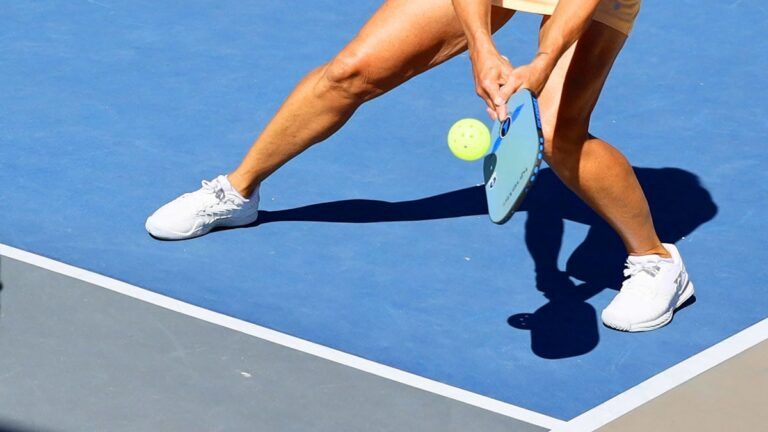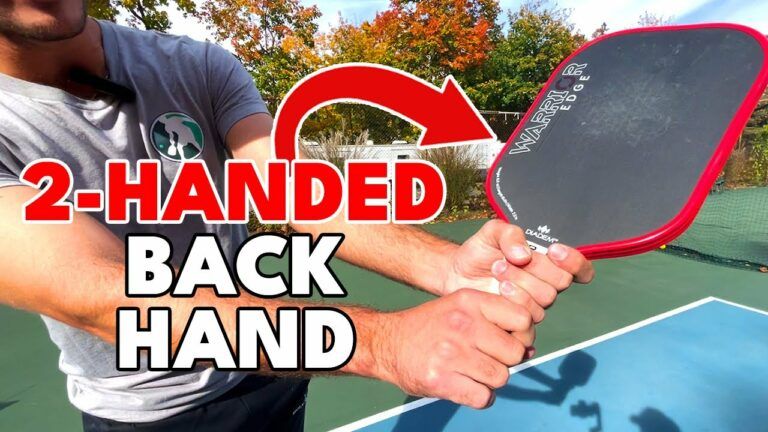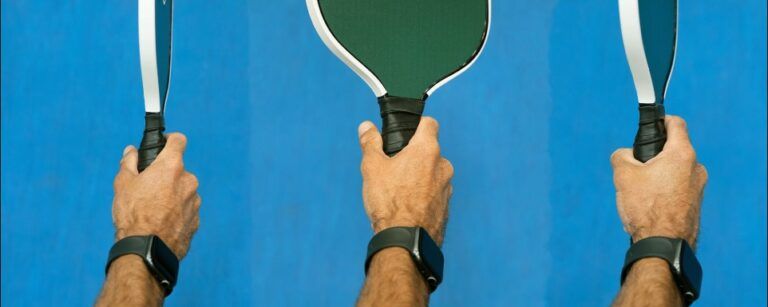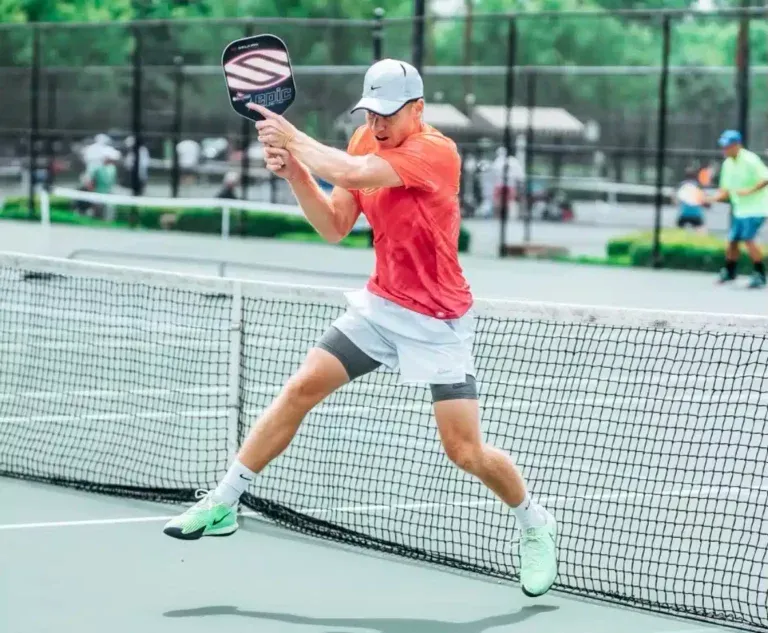The rise of the "Twoey"
The two-handed backhand has seen a meteoric rise in popularity among pickleball players of all skill levels. No longer considered just a technique borrowed from tennis, it has carved its niche in this racquet sport, becoming a key component of effective play. The versatility it offers is impressive, transforming how players maneuver on the court. The two-handed grip enhances not only the power behind shots but also the control and precision, making it a favored choice.
Why the two-handed backhand in Pickleball?
The advantages of a two-handed backhand are numerous and impactful. First and foremost, players can execute shots with a significantly higher degree of stability. The grip allows for a stronger foundation, which translates into more powerful shots. When paired with effective footwork, the two-handed backhand also enables players to generate topspin more effectively, a skill essential for controlling the ball's trajectory.
Moreover, this technique allows players to remain competitive against powerful serves and aggressive opponents by granting them the ability to respond effectively and with finesse. The two-handed backhand may initially seem complex, but with dedicated practice, it proves to be a game-changer.

One hand or two? Choosing the right style
The decision to lean towards a two-handed backhand or maintain a one-handed grip is no trivial matter. Each has its merits where one style can offer swift mobility, the other provides a robust defensive play. When dissecting backhand styles, players often weigh factors like power, finesse, and the specific demands of their playing style.
Pros and Cons:
- One-Handed Backhand:
- Pros: Quick response time, flexibility in reaching balls.
- Cons: Requires significant wrist strength; can be less stable under pressure.
- Two-Handed Backhand:
- Pros: Enhanced power, stability, better control over shots.
- Cons: Slightly more challenging in terms of footwork, can limit reach.

Ultimately, players must experiment to discover which technique best aligns with their natural tendencies and court strategies. This personal exploration will promote development, as comfort and reliability often breed confidence on the court.
Mastering the fundamentals
To harness the true potential of the two-handed backhand, it is paramount to focus on mastering its fundamental aspects. Attention must be paid to grip, footwork, and stance, as these elements play vital roles in both the execution and effectiveness of the shot.

The two-handed grip: A step-by-step guide
The correct grip is the cornerstone of an effective two-handed backhand. The dominant hand should be positioned at the bottom of the paddle grip, while the non-dominant hand rests above it. Both hands should touch, but avoid overlap; for right-handed players, the left pinky should lightly touch the right index finger. This placement fosters stability and promotes control during the swing.
Key Components of Grip:
- Hand Placement: Firm but flexible fingertips.
- Grip Style: Typically using a combination of Eastern and Continental grips for the dominant hand and a blend of Continental and Australian grips for the non-dominant.
- Common mistakes: Avoid gripping the paddle too tightly; this limits fluidity and can lead to control issues.
Footwork and stance: Setting up for success
Just as a well-crafted foundation is essential for any structure, correct footwork and stance are critical for executing the two-handed backhand. Players should adopt a stance with feet shoulder-width apart and knees slightly bent this prepares them for dynamic movement.
As the player gets ready for a shot, pivoting to turn sideways helps show the court a smaller profile, facilitating better responses to incoming balls.
This positioning ensures a fluid transfer of weight into the shot, contributing to greater power and control. Focusing on footwork nuances allows players to reposition themselves efficiently, ultimately improving shot outcomes.
Generating power: The kinetic chain
Unleashing a powerful two-handed backhand relies heavily on understanding the kinetic chain the interconnected movements that contribute to shot generation. Each segment of the body, from the feet to the fingertips, plays a pivotal role in creating not just power but also accuracy.
Engaging the lower body: The foundation of power
The lower body serves as the launching pad for any powerful shot. Engaging the legs, hips, and core paves the way for a strong upper body movement. The sequence begins with bending the knees, generating a solid base, and rotating the hips sufficiently as the paddle prepares to swing.
- Legs: Bend knees and initiate with a grounded position.
- Hips: Rotate to build momentum for a strong shot.
- Core: Activate to stabilize and support upper body movements.
This series of movements creates a fluid and powerful shot that is anchored in a player's lower body strength.
Upper body follow-through: Completing the motion
The follow-through – a step that is often overlooked but crucial for a successful shot – will determine how the ball travels after contact. A thorough follow-through should extend over the dominant shoulder, with the elbow pointing off to the side. This movement not only aids in power continuity but also improves accuracy.
Encouraging proper follow-through mechanics transforms what might have been a simple strike into a calculated shot that can change the game’s momentum.
Common errors and how to correct them
Recognizing the most common mistakes players make while executing a two-handed backhand is vital for improvement. Overcommitting to arm strength instead of leveraging the body's kinetic chain, for example, is a frequent error among beginners.
- Poor Timing: Causes inconsistent shot execution.
- Hinging at the Back: Often results in reduced power.
- Overusing Arms: Leads to fatigue and possible injury.
By focusing on correcting these tendencies, players can ensure better power generation and enhance their overall performance in pickleball.
The two-handed backhand arsenal
Arming oneself with a diverse arsenal of shots significantly enhances the gameplay experience. The two-handed backhand enables various strategic shots, including driving, dinking, dropping, and even serving return, each demanding specific techniques.

The backhand drive: A weapon for offense
The backhand drive is crucial within the competitive landscape of pickleball. It requires a compact swing with a low-to-high trajectory, allowing players to hit through the ball effectively.
Striking with precision and power becomes essential, as players who can successfully deliver drives will often dictate the flow of a game.
The backhand dink: Control and deception
The backhand dink invites nuance and finesse, providing a chance to outsmart opponents with soft touches and controlled placement. Adjustments in both grip and stance play significant roles in successfully executing this shot.
- Grip adjustments for delicate touch.
- Controlled paddle movement ensuring finesse.
- Strategic placement of the dink to challenge opponents’ positioning.
Different techniques may be necessary for variations in court positioning, but ultimately, a well-placed dink can shift the tides of a game.
The backhand drop: Mastering the finesse shot
A well-executed backhand drop shot demands precise wrist action to create topspin, enhancing the ball's trajectory. Mastering this finesse shot requires awareness of the angle and timing needed.
- Wrist Action: Generate topspin for effective drops.
- Footwork: Positions the player correctly for execution.
- Situational Use: When under pressure or anticipating defensive responses.
Timing the drop shot against a player’s momentum can create advantageous openings and lead to points won outright.
The backhand speed up: Catching your opponent off guard
The backhand speed-up is an aggressive tactic that capitalizes on an opponent’s lack of readiness. Successful execution requires a fluid transition from a defensive to an attacking setup, paired with strategic wrist action.
The backhand return of serve: Setting the tone
An intimidating backhand return of serve can destabilize the offensive player and shift the game’s tenor. Generating power and hitting deep into the opponent's court can force errors and open up more opportunities on the following rallies.
Strategies for Effective Returns:
- Adjust based on the serve type (soft vs. spin).
- Focus on maintaining depth and consistency.
Advanced techniques and strategies
As players become comfortable with the two-handed backhand, they can explore advanced techniques, allowing their gameplay to evolve even further. The ability to deceive opponents and adapt to various court situations equips players with the tools necessary to excel.
The two-handed backhand as a tool for deception
The beauty of the two-handed backhand lies in its inherent potential for deception. Utilizing a similar grip and swing for various shots can create unpredictability, making it hard for opponents to anticipate the outcome.
- Variations in grip pressure can control shot direction.
- Subtle differences in swing path add unpredictability and keep opponents guessing.
Adapting to different court positions
Regardless of skill level, adapting to one’s court position is essential for effective shot execution. The two-handed backhand can accommodate various positions on the court, whether at the baseline, in the transition zone, or near the kitchen line.
By bridging these adjustments into practice, players can enhance their strategic play as they battle through increasingly competitive matches.
Drills and practice: Honing your skills
To incorporate the two-handed backhand into everyday practice, players should engage in targeted drills. These can range from solo to partner practices, focusing on everything from grip stability to shot power.
Solo drills: Building a solid foundation
Solo drills can be an effective way to engage in self-instruction, allowing for focused practice on specific components of the two-handed backhand.
- Shadow Swings: Practice grip, swing, and footwork without hitting a ball.
- Wall Drills: Utilize a wall to practice returning shots repetitively.
Partner drills: Developing consistency and strategy
Working with a partner not only enhances shot precision but also simulates game situations necessary for growth.
- Repetition Drills: Focus on consistency by alternating shots.
- Game Situation Drills: Practice under scenarios that mimic a real match.
Putting it all together: Match play application
As players refine their technique, integrating the two-handed backhand into actual gameplay scenarios becomes essential. Building confidence in the shot setup allows players to transition this practice into match play seamlessly.
Biomechanics and injury prevention
Understanding biomechanics is crucial for optimal performance and injury prevention related to the two-handed backhand.
Understanding the biomechanics of the two-handed backhand
The two-handed backhand utilizes multiple muscle groups, reinforcing the integrity of movements. Efficient biomechanics ensure every shot maximizes power while minimizing injuries over time.
- Key muscle groups used include legs, core, and upper body.
- Proper body mechanics ensure consistent and powerful movement patterns.
Common injuries and prevention strategies
Transitioning to a two-handed backhand style may introduce risks, particularly for players familiar with other racquet sports. Awareness of common injuries related to this technique, and encouraging proper warm-up and cool-down routines, can mitigate risks.
- Stretching: Ensures muscle flexibility.
- Warm-Up Routines: Increases blood flow and prepares muscles.
- Cool-Down Practices: Aids muscle recovery after sessions.
Conclusion: Elevate your game with the Twoey
As we explore the depths and nuances of the two-handed backhand in pickleball, it becomes evident that this technique delivers a blend of power, control, and versatility. The increase in effectiveness this shot provides can transform gameplay, bringing both enjoyment and competitiveness into every match. By mastering its mechanics from grip to footwork and advanced strategies players can elevate their performance, winning matches and leaving a significant mark on the court. Whether you are a seasoned player or a newcomer, harnessing the potential of the two-handed backhand will undoubtedly enhance your pickleball experience.










